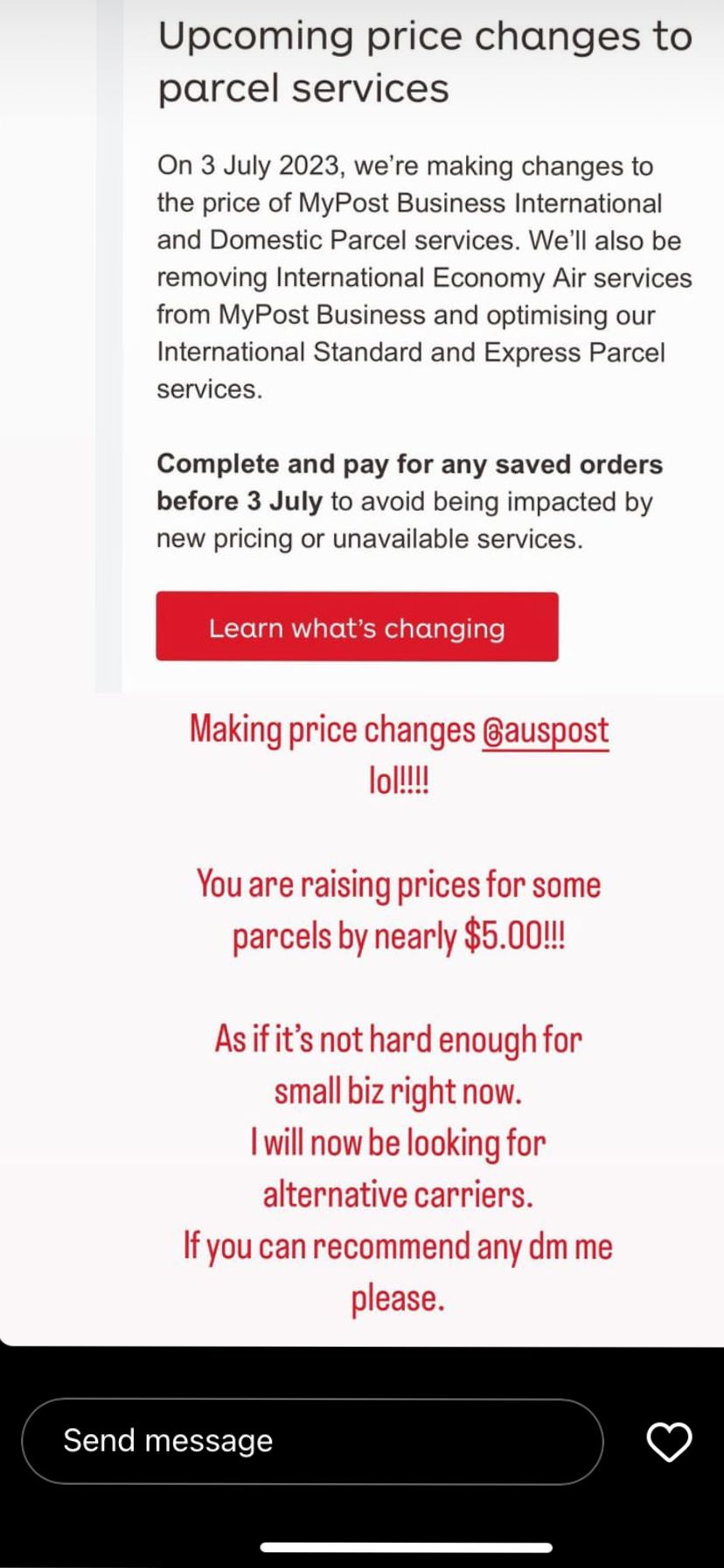
Image: Supplied
Next month Australia Post will be raising some of its prices, making it more expensive to send packages domestically and internationally. Some Australian small businesses have spoken out against the changes, saying it has become too expensive to send packages and they’re looking at alternatives.
At least two small businesses say the changes will mean they will need to pay an extra $5 to send some parcels, while another expects its overall shipping costs to increase by 10%.
This news comes just weeks after we revealed that Australia Post is axing ‘Sorry we missed you’ cards for MyPost customers. This sparked a slew of responses from our readers and on social media. The vast majority of the personal experiences shared involved an alleged decline in customer service from Australia Post, particularly when it comes to parcel delivery.
What the Australia Post price increases look like
MyPost business customers were alerted to the upcoming price increases at the beginning of June, with the changes to come into effect on Monday, July 3.
“We are working harder than ever to ensure we provide commercially sustainable services and products for our customers,” Australia Post said in an email viewed by SmartCompany.
“We’re writing to you today to advise of changes to the price and availability of some of our retail products and services from 3 July 2023, which affect MyPost Business rates and savings.”
In the email, attributed to Australia Post’s Executive general manager of parcel, post and e-commerce services Gary Starr, the organisation said it is focused on “simplifying our products and services”.
This includes the removal of its International Economy Air parcel service via MyPost Business, and separately, a decrease in volume-based savings of between 2.5% and 5% for customers on Bands 3-5.
There also be a new $13.95 price for MyPost Business Parcel Pickups for customers on Bands 0-3.
Expanding out, there will also be price increases across the board for anyone sending domestic or international packages or letters.
Express Post Platinum and Express Post Saturday delivery services are also being removed. International Economy Air (own packaging) will also no longer be available via MyPost Business, but will still be available at post offices.
Australia Post says it has to increase prices due to current economic pressures
Speaking to SmartCompany over the phone, Starr confirmed that Australia Post reviews its prices every year around July.
Starr also said the mail carrier tries to give customers as much notice as possible about any changes.
“Customers never like price increases from any supplier… but we’ve explained the inflationary pressures we’re seeing for our operational costs — particularly labor, energy and fuel,” Starr said.
“It’s never easy to increase prices and we always try to take a very balanced view in terms of increasing prices and ensuring a value for money offer, but also making sure that we can run the business sustainably and keep investing in the network which is so important as online shopping continues to grow.”
Starr also confirmed that a large portion of Australia Post’s workforce is covered by Enterprise Bargaining Agreements (EBA) and it is trying to “do the right thing” by paying in line with the Consumer Price Index (CPI).
“Last year there was a 6.1% increase and we all know what inflation is doing at the moment. So there’ll be another increase of a similar amount this year,” Starr said.
“For our team members, their pays are increasing roughly with inflation but it does have a big impost on our business.”
Starr also points to the current price of fuel, saying that Australia Post hasn’t factored the rising cost into retail or MyPost Business pricing, until now.
“Fuel has gone up 50% over the last few years and that’s obviously a significant impact on our business as well,” he added.
Fuel is just one expense that Australians have seen skyrocket over the last year. Interest rates, rent, power, groceries and general cost of living have jumped significantly.
While Australia Post does review its prices every year, perhaps the increase is being felt by small businesses more significantly this time around because of the current economic climate.
“I can’t comment on every case but some of the [business] customers I speak to — micro, small, medium and large — are all seeing it at the browser and at the supermarket,” Starr said.
“When we sit down and explain the billion dollars we’ve invested in the last three years in our network and the services we provide, the reach we have and investment in sustainability, they do understand. Because they’re seeing it in every other part of their lives.”
“Is there more noise? I don’t know. I just know that it’s never an easy discussion but customers do ultimately understand they do have choices so they will evaluate.
“They will look at value for money and they do understand that if we don’t invest in the network and don’t continue to provide these investments in scanning and notifications in our app that their customers — the people they sell to — want a compelling experience.”
These small businesses refuse to raise their own prices
Regardless of the economic reasoning behind the changes, some small businesses aren’t happy about the upcoming higher price tags attached to shipping.
“Making prices changes @auspost lol!!!!” one small business said in an Instagram story.
“You are raising prices for some parcels by nearly $5.00!!!”
“As if it’s not hard enough for small biz right now. I will now be looking for alternative carriers.”

Image: Instagram
Cassie Sanghvi, co-founder of The Base Collective, agrees with this business owner, telling SmartCompany the price rise “feels like another blow” amongst the rising costs of living and operating a small business in Australia.
The Base Collective also came to a similar estimate, around the $5 mark, when it worked out how much more some packages will now cost to send to customers after July 3.
“When you’re selling items that are under the $100 mark, it definitely adds a big impact,” Sanghvi said on the phone to SmartCompany.
“We’re on a mission to really try to bring calm through everyone’s well-being as a magnesium-focused brand. This doesn’t seem the right thing to do, especially with the current climate.
“We won’t be passing this [cost] onto our customer. But what we will be doing is starting to look outside the box. It’s time to explore other delivery options, other couriers, and even Uber when it comes to ultra-local deliveries.”
Sanghvi says the business will also try other methods to reduce shipping costs, such as encouraging customers to click and collect from its stockists.
“The problem does come with rural and regional areas. But we’re committed to expanding our attribution network and trying to get more stockists in those locations.”
Melbourne-based Elysia Krstevski, founder of Meke Baby, says Australia Post’s price changes might increase her postage costs by almost 10%.
“As a small business with a premium product being marketed to new parents, I need to be really mindful of the balance of pricing,” Krstevski said in an email to SmartCompany.
Krstevski makes the point that consumers are now conditioned to expect free or discounted shipping when buying online.
“As a small business I need to factor in these expectations while still keeping competitive as well as profitable. I currently offer free shipping and want to continue that offer so these changes will potentially be impacting my profit margins, unfortunately,” Krstevski said.
Despite the rising costs of operating a small business, both Sanghvi and Krstevsk were unwilling to make their own customers pay more.
“I know as an online shopper myself that free shipping and returns indicate a store’s great service standards, which is why I’ll keep offering it to my own customers,” said Krstevsk.
“But these changes do mean I might need to reconsider my postage options and look at alternatives. While my business is doing well, it adds another consideration to how I forecast the cost of doing business moving forward.”
Handpicked for you

Australia Post to axe “Sorry we missed you” cards for MyPost customers



COMMENTS
SmartCompany is committed to hosting lively discussions. Help us keep the conversation useful, interesting and welcoming. We aim to publish comments quickly in the interest of promoting robust conversation, but we’re a small team and we deploy filters to protect against legal risk. Occasionally your comment may be held up while it is being reviewed, but we’re working as fast as we can to keep the conversation rolling.
The SmartCompany comment section is members-only content. Please subscribe to leave a comment.
The SmartCompany comment section is members-only content. Please login to leave a comment.